Tom Parkinson's monthly column, introducing the diverse range of flora and fauna on show at Sanctuary Lakes.
One of the delights of Sanctuary Lakes living is that almost every home has a big or small garden. Our estate lies on the fertile wetland fringe of the Great Western Basalt Plain, but due to the last one hundred and seventy years of multi changes of land use, from native grassland to pastoral, to salt pans and now residential, the area was until quite recently regarded as an endangered ecosystem. Fortunately, over the past decade Sanctuary Lake’s maintenance staff, golf course keepers and landscapers have worked to reveal the unique beauty, diversity and significance of our ecosystem by planting species related to our original native grassland such as wildflowers, bulbs and lilies, shrubs, grasses and trees. Their success can also be measured in the number of birds, reptile and animal species that have joined our neighbourhood, thanks to the renewed native vegetation.
There are numerous plants indigenous to this area. Local plants require less maintenance, having the advantage of being the most water wise and able to adapt to the climate and soil conditions. For those who would like to encourage more native fauna into your garden I thought we could highlight just a few of the iconic local bushes, shrubs, flowers and ground covers, that not only thrive and look great, but are known to attract native birds and butterflies.
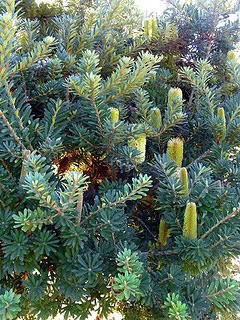 Firstly, an impressive colourful shrub the Silver Banksia
Firstly, an impressive colourful shrub the Silver Banksia
Silver Banksia - Banksia Marginata
Silver Banksia, is a hardy, fast growing (up to 2m) and long-lived species, that thrives in our soil and climate. It is drought resistant and does well in exposed windy conditions. The long, cylindrical pale-yellow flowers can occur throughout the year, but mainly February to July. The seed ripens from February to April, and is indicated by the wood hardening and the follicle colour changing to dark brown. Like all banksias, the Silvers produce copious nectar and are ideal for attracting wildlife into gardens. The main pollinators are nectar feeding birds, in particular honeyeaters, especially the New Holland Honeyeater. Seeds are also eaten by cockatoos, particularly the Corella and Yellow-tailed Black Cockatoo.
Our second shrub is the very hardy Rosemary Grevillea, that occurs naturally on the basalt grasslands.
Rosemary Grevillea - Grevillea Rosmarinifolia
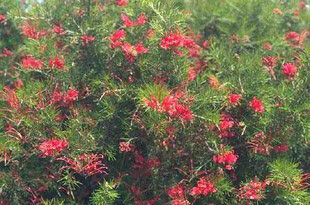
Rosemary Grevillea sometimes called the Spider Flower, is one of the most popular Grevilleas, providing a dense and bushy, up to one metre high, ground cover of evergreen foliage, contrasted by short racemes of very pretty red spidery flowers.
The foliage is spiky (narrowly elliptical), arranged alternately along the stems, similar to Culinary Rosemary (from which it takes its species name). Each leaf is also glossy green on top and a downy grey/green underneath.
The red to pink flowers are produced in pairs along the branches and are made up of downward curving tubes that are fused together but split at the ends where the colour turns to cream. They are spectacular flowers for their compact size and the key reason for the success of this plant in cultivation. Flowering is usually in spring but a happy plant will produce further flushes of flowers throughout the year.
The flowers are full of nectar and will attract birds, bees and insects to your garden.
Now some terrific local flowers
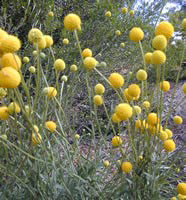 Billy Buttons - Pycnosorus Globosus
Billy Buttons - Pycnosorus Globosus
Also known as Drumsticks, this unique Australian native is a one of our most popular cut flower exports. Perfect spheres of butter yellow rise above the slender silver foliage throughout spring and summer. A perennial plant which has an underground rhizome, so if the plant dies off it can re-sprout. The flowers are hemispherical to spherical and are formed of tiny flowers (florets) without any surrounding ligules. Flowering from spring to summer, the blooms are superb cut flowers and for drying. Drought tolerant but best on a moist and well-drained soil, in sun to part shade. Frost hardy, and loves coastal gardens and enjoys the Sanctuary Lake soils. In the wild the Drumstick was once a common plant found along swamps and wetlands but outside cultivated areas it is now sadly, extremely rare.
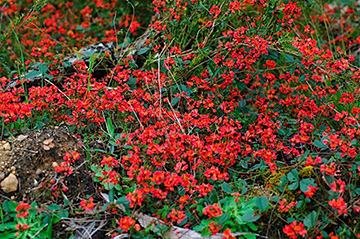 The Running Postman - Kennedia Prostrata
The Running Postman - Kennedia Prostrata
The name alone, Running Postman, makes you curious about this very attractive trailing ground cover, twining plant, with soft green, clover-like leaves and a large showy, extraordinary bright, scarlet red, pea-shaped flowers, that burst out in late winter through to mid-summer. It enjoys the dry, well drained, gravelly-clay soil of our Estate and accepts full sun or light shade.
The flowers are rich in nectar and attractive to all honey eating birds.
The Postman makes a great trailing ground cover or a restrained climber. Grows equally well under trees, in containers or hanging baskets. Cascades well over an embankment or retaining walls, but above all it is the spectacular display of the fiery red flowers that impresses the Running Postman on your memory.
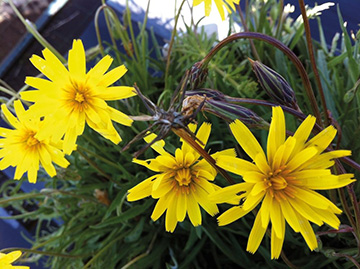 Murnong Yam Daisy - Microseris Lanceolata
Murnong Yam Daisy - Microseris Lanceolata
Finally, we have looked at plants which attract Birds, Butterflies and Insects, but what about one that we Residents could eat as well. The standout edible indigenous plant of the Basalt Plain is Murnong or Yam Daisy.
Pre-European, it was the starchy staple of the Victorian Koorie population. Early settlers reported seeing fields full of the yellow flowered perennial herb with a mass of women and children harvesting the plump roots with digging sticks. When harvested the Yam Daisy roots resembled neutral coloured small swedes and when roasted they have a texture and taste similar to sweet potatoes.
Unfortunately, the above ground leafy foliage was highly attractive to the first introduced grazing animals and this essentially, along with the planting of European grasses, caused the demise of the Yam Daisy.
The Yam Daisy is an absolute native to our district and therefore very easy to grow in Sanctuary Lakes. It is perennial plant forming a rosette of long narrow slightly toothed leaves. Bright yellow flowers with distinctive drooping buds, it flowers through spring and early summer. It's yellow head of florets are reminiscent of a Dandelion. Indeed, like the Dandelion the seed heads ripen to a fluffy cluster and are dispersed by the wind.
I can guarantee serving home grown Yam roots at your BBQ will certainly make a talking point between the snags and steaks.
Most plant nurseries have an Australian Native section and I am certain most of these plants are readily available, but if you want to go to a retail nursery that specialises in indigenous plants, the two nearest to Sanctuary Lakes are the Newport Lakes Native Nursery, in Lake Drive, Newport or Iramoo Nursery, Victoria University, St Albans Campus.